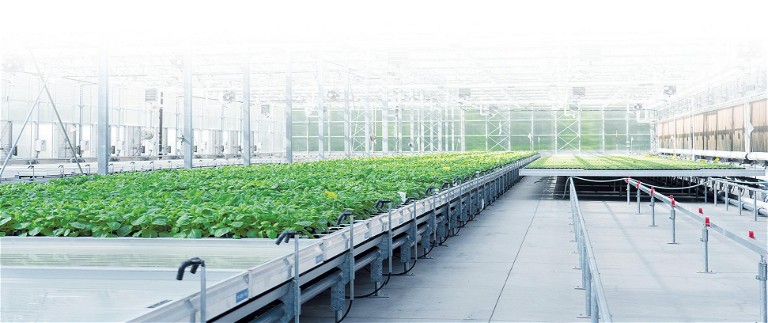New Methods in Drug Development
Vaccine Technology, Inspired by Plants
The history, the science, and the constantly evolving possibilities of plant-based vaccine technology open up the scientific community to alternative vaccine candidates
Brian J Ward at Medicago

The impact of the global pandemic put vaccine technology instantly in the spotlight. The need for a variety of manufacturing technologies to meet the challenges of today, and to prepare the world for future outbreaks has never felt more obvious. An unprecedented array of both traditional and novel vaccine development approaches has been deployed. Among the latter, plant-based vaccine candidates could play an important role in the continued struggle against coronavirus, and a major role in the response to future pandemics.
The Origin of Plant-Based Vaccines
Initial efforts to use plants to produce vaccines focused on the idea of so-called ‘edible vaccines’ that were based on transgenic crops, such as potatoes or bananas. Although this early work showed promise, plant-based vaccine technology took a major leap forward with the idea of using plants as bioreactors – or mini-factories – to create the key biological components of vaccines. The platform technology currently in use has been in development for more than three decades: it is considerably faster than the original transgenic approach, and avoids the controversies associated with genetically modified organisms. The first candidate plant-based vaccines produced by transient transfection were reported in 1989 at the Scripps Research Institute in California. Believing in the potential of the technology, a growing number of groups worked hard through the early 1990s to assess the promise of the approach. In 1998, scientists at the National Institute of Allergic and Infectious Diseases demonstrated that plant-based vaccines could elicit strong immune responses, a significant milestone in the evolution of this technology. In 2006, the United States Department of Agriculture approved the first plant-based vaccine to protect poultry against the Newcastle disease virus (1). Although plant-based vaccines have since become well-established in veterinary medicine, confidence in the technology to combat human disease has been slower to develop.
However, plant-based technology has the ability to respond to new and emerging global health threats, including pandemics. In a ‘rapid fire’ demonstration test in 2012, 10 million researchgrade doses of an H1N1 (swine flu) influenza vaccine were produced in just one month for the Defense Advanced Research Project Agency ‘Blue Angel’ programme. Plant-based technology has come a long way since 1989, and, in many ways, reflects the progress and the evolving sophistication of the entire industry.
Starting With the Perfect Plant
Developing an effective plant-based vaccine begins with finding the perfect plant. Many plants are prolific natural producers of proteins, potentially making them efficient ‘factories’ for vaccine or antibody production. Speed of growth, the volume of potential growth (often indicated by leaf size) and the capacity to transiently host foreign genetic material (i.e., the gene encoding a monoclonal antibody or a vaccine antigen) are all taken into consideration when assessing the suitability of a plant species as a bioreactor. Plant-based vaccine developers have experimented with a wide and sometimes surprising range of plants to identify the most effective natural hosts, including microalgae, moss, wheat, melons, tomatoes, carrots, lettuce, and sunflowers (2).
In 1999, the Alfalfa plant was a widely available perennial that showed promise as a vaccine bioreactor in transgenic models. Surveying both transgenic and non-transgenic models led to the ideal candidate in the early 2000s – Australian plant Nicotiana benthamiana. This robust little plant, a very distant relative of the American tobacco plant, was increasingly used in laboratories around the world because of the ease with which foreign genetic material could be introduced to drive the transient expression of proteins of interest (3). The plant’s hardiness, as well as its rapid growth rate and large leaves, translates into the production of large quantities of the targeted proteins.
How to Make a Plant-Based Vaccine
Plant-based vaccines share many characteristics with other recombinant technologies, in which the gene encoding a specific antigen, such as a viral receptor-binding protein, is introduced into a cell. Although insertion of the genetic information can be accomplished in many ways, one of the most efficient methods in plant-based systems is the use of a bacterium that has all of the necessary ‘machinery’ to insert its own genes into plant cells. For the N. benthamiana platform, the ideal bacterium is Agrobacterium tumefaciens that has been attenuated, so that it no longer makes the plants sick, and has been modified, so that it inserts the genetic information to drive production of the vaccine protein instead of its own proteins.
In Medicago’s platform, young six- to eight-week-old plants are exposed to the modified A. tumefaciens using a large bath, into which the plants are submerged upside-down: a process called ‘agro-infiltration’. Once the leaves are fully immersed, a vacuum is applied to the roots to empty the vascular system of the plant, which collapses like a squeezed sponge. When the vacuum is released, the bacteria-laden liquid is rapidly drawn into the plant’s leaves, permitting the introduction of the gene of interest into almost every cell in the plant’s leaves simultaneously. The plants are then withdrawn from the bath and returned to a carefully controlled greenhouse to grow. Over the next four to seven days, each plant acts like a miniature vaccine factory: all of its leaves produce vast quantities of virus-like particles (VLPs) that spontaneously bud from the surface of each cell and collect in the space between the cell membrane and the plant cell wall, until they are extracted and purified to act as a vaccine.
The Power of VLPs
Plant-based VLPs are complex protein-lipid structures that can mimic the size and shape of real virus particles. Because VLPs lack the genetic material of an intact wild type virus particle, they look like real viruses, but are non-infectious and unable to replicate.
One of the reasons that plant-based VLP vaccines have real potential is the observation that VLPs produced using non-plant systems have already delivered some very effective, approved vaccines. Examples include the VLP vaccines used for hepatitis B and human papilloma that have proved to be very efficient at delivering antigens to the human immune system (4). These commercial VLP vaccines lack the viral genetic core, so they can trigger a highly-targeted immune response against a protein that is critical to the survival of the virus, but are non-infectious.
The Appeal of Plant-Based Technology
The versatility of the recombinant process used to create plant-based vaccines is just one of the appealing features of the technology. As the process starts by inserting the genetic information for a specific viral antigen into the plant cell, vaccines have the potential to be tailored to virtually any virus strain. This can also be done quickly. Although it takes much longer to produce a commercial vaccine at scale, it can take as little as 20 days to produce an initial VLP candidate. Back in 2009, during the outbreak of swine flu, a plant-based vaccine candidate was provided just 19 days after the publication of the viral genetic sequence. In March 2020, scientists produced the first coronavirus VLPs bearing the spike protein just 20 days after receiving the SARS-CoV-2 gene.
In addition to the speed of plant-based recombinant technology, these platforms are also versatile since they have the potential to be used to produce both vaccines and monoclonal antibodies. Monoclonal antibodies are currently used to treat many infectious and non-infectious conditions, including many cancers and autoimmune/inflammatory diseases (5). As a result, the power of plants has the potential to be harnessed to generate a wide array of preventative and therapeutic products.
The Future for Plant-Based Vaccines and Therapeutics
The coronavirus pandemic has clearly established the need for multiple technologies to work side by side to meet the challenge of global health threats, and the plant-based platform is ready to play a role in this future.
In March 2021, a Phase III trial of a plant-based coronavirus vaccine candidate was launched. If this proves to be safe and effective, it is possible that this candidate will become the first plant-derived vaccine licensed for human use, as well as being a potential catalyst to establishing this platform as part of the response to future public health threats. Achieving this milestone could be a key component in helping to overcome the natural resistance in both the scientific and lay communities to the introduction of a new idea or unfamiliar technology.
The ongoing coronavirus pandemic has made it abundantly clear that the world would be unwise to become overly reliant on any single technology or company to produce vaccines and therapeutics. The more platforms that can be called upon in a crisis, and the more diverse these platforms are, the greater the likelihood that populations around the world will be able to be protected from future pandemics.
References
3. Visit: www.nature.com/articles/nplants2015165
4. Visit: pubmed.ncbi.nlm.nih.gov/28887001

Dr Brian Ward is Medical Officer at Medicago and Professor of Medicine and Microbiology at McGill University, Canada. During his 30-year career at McGill, he served as the chief of the Division of Infectious Diseases, Deputy Director of the Research Institute of the McGill University Health Centre, Director of the McGill Vaccine Study Center, and Associate Director of the JD MacLean Centre for Tropical Diseases. Dr Ward has served on a wide range of national and international advisory committees in the areas of vaccine use, vaccine safety, and international health. His current research in vaccine development is supported by Canadian and international funding agencies, as well as private foundations and industry. As a student at McGill, Dr Ward received numerous scholarships and awards including a Rhodes Scholarship (Québec – Corpus Christi, Canada). He completed medical training at McGill University, followed by residency and fellowship training in tropical medicine at the University of London, UK, internal medicine and infectious diseases at Johns Hopkins University, US, and microbiology at McGill.